On the Changing Cool Season Affecting Rice Growth and Yield in Taiwan
Abstract
1. Introduction
2. Materials and Methods
2.1. Study Areas
2.2. Data Collection
2.2.1. Observed Rice Data
2.2.2. Observed Weather Data
2.2.3. Simulated and Projected Climate Data
2.3. Simulation Framework
2.3.1. ORYZA(v3) Calibration, Validation, and Evaluation
2.3.2. Downscaling of Outputs from Climate Model
2.3.3. Simulation of Potential Rice Growth and Yield
3. Results
3.1. ORYZA(v3) Performance
3.2. Response of Rice Phenology on Warming Trend
3.3. Spikelet Sterility Because of Temperature
3.4. Future Change of Rice Yield with Warming but without Rising CO2
3.5. Effects of Rising CO2 on Rice Yield
4. Discussion
5. Conclusions
Supplementary Materials
Author Contributions
Funding
Data Availability Statement
Acknowledgments
Conflicts of Interest
References
- Krishnan, P.B.; Ramakrishnan, K.R.; Reddy, V.R. High temperature effects on rice growth, yield and grain quality. In Advances in Agronomy, 1st ed.; Sparks, D.L., Ed.; Elsevier: Amsterdam, The Netherlands, 2011; Volume 111, pp. 87–206. [Google Scholar]
- Council of Agriculture. Yearly Report of Taiwan’s Agriculture: Agricultural Production. Available online: https://eng.coa.gov.tw (accessed on 26 January 2019).
- Lee, M.H. Low temperature tolerance in rice: The Korean experience increased lowland rice production in the Mekong Region. In Proceedings of the ACIAR Proceedings No 101, Vientiane, Laos, 30 October–2 November 2000; Fukai, S., Basnayake, J.W.M., Eds.; Australian Centre for International Agricultural Research: Canberra, Australia, 2001. [Google Scholar]
- Ghadirnezhad, R.; Fallah, A. Temperature effect on yield and yield components of different rice cultivars in flowering stage. Int. J. Agron. 2014, 2014, 846707. [Google Scholar] [CrossRef]
- Hsu, H.-H.; Chen, C.T. Observed and projected climate change in Taiwan. Meteorol. Atmos. Phys. 2002, 79, 87–104. [Google Scholar] [CrossRef]
- Hsu, H.-H.; Chou, C.; Wu, Y.-C.; Lu, M.-M.; Chen, C.-T.; Chen, Y.M. Climate Change in Taiwan: Scientific Report 2011 (Summary); National Science Council: Taipei, Taiwan, 2011; p. 67. [Google Scholar]
- Matthews, R.B.; Kropff, M.J.; Horie, T.; Bachelet, D. Simulating the impact of climate change on rice production in Asia and evaluating options for adaptation. Agri. Syst. 1997, 54, 399–425. [Google Scholar] [CrossRef]
- Chang, C.-C. The potential impact of climate change on Taiwan’s agriculture. Agric. Econ. 2002, 27, 51–64. [Google Scholar] [CrossRef]
- Chen, C.-C.; Chang, C.-C. The impact of weather on crop yield distribution in Taiwan: Some new evidence from panel data models and implications for crop insurance. Agric. Econ. 2005, 33, 503–511. [Google Scholar] [CrossRef]
- Chiuen, Y.-W.; Huang, C.C.; Tan, C.H. Modeling the rice-climate indices in Taiwan. Clim. Chang. Econ. 2013, 4, 1350012. [Google Scholar] [CrossRef]
- Wu, S.J.; Chiueh, Y.-W.; Lien, H.-C.; Hsu, C.T. Modeling risk analysis for rice production due to agro-climate change in Taiwan. Paddy Water Environ. 2015, 13, 391–404. [Google Scholar] [CrossRef]
- Rosenzweig, C.; Elliott, J.; Deryng, D.; Ruane, A.C.; Müller, C.; Arneth, A.; Boote, K.J.; Folberth, C.; Blotter, M.; Khabarov, N.; et al. Assessing agricultural risks of climate change in the 21st century in a global gridded crop model intercomparison. Proc. Natl. Acad. Sci. USA 2014, 111, 3268–3273. [Google Scholar] [CrossRef] [PubMed]
- Li, T.; Hasegawa, T.; Yin, X.; Zhu, Y.; Boote, K.; Adam, M.; Bregaglio, S.; Buis, S.; Confalonieri, R.; Fumoto, T.; et al. Uncertainties in predicting rice yield by current crop models under a wide range of climate conditions. Glob. Chang. Biol. 2015, 21, 1328–1341. [Google Scholar] [CrossRef]
- Zhang, J.; Feng, L.; Zou, H.; Liu, D.L. Using ORYZA2000 to model cold rice yield response to climate change in the Heilongjiang province, China. Crop J. 2015, 3, 317–327. [Google Scholar] [CrossRef]
- Pugh, T.A.M.; Müller, C.; Elliott, J.; Deryng, D.; Folberth, C.; Olin, S.; Schmid, E.; Arneth, A. Climate change analogues suggest limited potential for intensification of production on current croplands under climate change. Nat. Commun. 2016, 7, 12608. [Google Scholar] [CrossRef] [PubMed]
- Yen, M.-C.; Chen, T.C. Short communication seasonal variation of the rainfall over Taiwan. Int. J. Climatol. 2000, 20, 803–809. [Google Scholar] [CrossRef]
- NOAA Website. Available online: Ftp://aftp.cmdl.noaa.gov/data/trace_gases/ (accessed on 29 September 2018).
- ESGF. Portal at CEDA. Available online: https://esgf-index1.ceda.ac.uk/search/cordex-ceda/ (accessed on 5 October 2018).
- Li, T.; Angeles, O.; Marcaida III, M.; Manalo, E.; Manalili, M.P.; Radanielson, A.; Mohanty, S. From ORYZA2000 to ORYZA (v3): An improved simulation model for rice in drought and nitrogen-deficient environments. Agric. For. Meteorol. 2017, 237–238, 246–256. [Google Scholar] [CrossRef]
- Bouman, B.A.M.; Kropff, M.J.; Tuong, T.P.; Wopereis, M.C.S.; ten Berge, H.F.M.; van Larr, H.H. ORYZA2000: Modeling Lowland Rice. International Rice; Research Institute: Metro Manila, Philippines, 2001; p. 235. [Google Scholar]
- Li, T.; Raman, A.K.; Marcaida III, M.; Kumar, A.; Angeles, O.; Radanielson, A.M. Simulation of genotype performances across a larger number of environments for rice breeding using ORYZA2000. Field Crops Res. 2013, 149, 312–321. [Google Scholar] [CrossRef]
- Zhang, S.; Tao, F. Modeling the response of rice phenology to climate change and variability in different climatic zones: Comparisons of five models. Eur. J. Agron. 2013, 45, 165–176. [Google Scholar] [CrossRef]
- Evans, L.T.; Fisher, R.A. Yield potential: Its definition, measurement and significance. Crop Sci. 1999, 39, 1544–1551. [Google Scholar] [CrossRef]
- Hawkins, E.; Osborne, T.M.; Ho, C.K.; Challinor, A.J. Calibration and bias correction of climate projections for crop modelling: An idealized case study over Europe. Agric. For. Meteorol. 2013, 170, 19–31. [Google Scholar] [CrossRef]
- Navarro-Racines, C.E.; Tarapues-Montenero, J.E. Bias-Correction in the CCAFS-Climate Portal: A Description of Methodologies. Available online: http://ccafs-climate.org/downloads/docs/BC_methods_explaining_v2_jrv.pdf (accessed on 16 August 2018).
- Parzen, E. On Estimation of a Probability Density Function and Mode; Technical Report No.40; Applied Mathematics and Statistics Laboratories, Stanford University: Stanford, CA, USA, 1961. [Google Scholar]
- Cimbala, J.M. Probability Density Function. Available online: https://www.mne.psu.edu/cimbala/me345/Lectures/Probability_density_functions.pdf (accessed on 14 January 2019).
- Matsui, T.M.; Omasa, K.; Horie, T. High temperature-induced spikelet sterility of Japonica rice at flowering in relation to air temperature, humidity and wind velocity conditions. Jpn. J. Crop Sci. 1997, 66, 449–455. [Google Scholar] [CrossRef]
- Zeng, Y.; Zhang, Y.; Xiang, J.; Uphoff, N.T.; Pan, X.; Zhu, D. Effects of low temperature stress on spikelet-related parameters during anthesis in Indica-Japonica hybrid rice. Plant Sci. 2017, 8, 1350. [Google Scholar] [CrossRef]
- Van Heemst, H.D.J. Crop phenology and dry matter distribution. In Modelling of Agricultural Production: Soil, Weather and Crops, 1st ed.; van Keulen, H., Wolf, J., Eds.; PUDOC: Wageningen, The Netherlands, 1986; pp. 13–60. [Google Scholar]
- Shimono, H. Earlier rice phenology as a result of climate change can increase the risk of cold damage during reproductive growth in northern Japan. Agric. Ecosyst. Environ. 2011, 144, 201–207. [Google Scholar] [CrossRef]
- Wang, X.; Ciais, P.; Li, L.; Ruget, F.; Vuichard, N.; Viovy, N.; Zhou, F.; Chang, J.; Wu, X.; Zhao, H.; et al. Management outweighs climate change on affecting length of rice growing period for early rice and single rice in China during 1991–2012. Agric. For. Meteorol. 2017, 233, 1–11. [Google Scholar] [CrossRef]
- Van Oort, P.A.J.; Zwart, S.J. Impacts of climate change on rice production in Africa and causes of simulated yield changes. Glob. Chang. Biol. 2018, 24, 1029–1045. [Google Scholar] [CrossRef] [PubMed]
- Devkota, K.P.; Manschadi, A.M.; Devkota, M.; Lamers, J.P.A.; Ruzibaev, E.; Egamberdiev, O.; Amiri, E.; Vlek, P.L.G. Simulating the impact of climate change on rice phenology and grain yield in irrigated drylands of central Asia. J. Appl. Meteorol. Climatol. 2013, 52, 2033–2050. [Google Scholar] [CrossRef]
- Van Oort, P.A.J.; de Vries, M.E.; Yoshida, H.; Saito, K. Improved climate risk simulations for rice in arid environments. PLoS ONE 2015, 10, e0118114. [Google Scholar] [CrossRef]
- Espe, M.B.; Yang, H.; Cassman, K.G.; Guilpart, N.; Sharifi, H.; Linquist, B.A. Estimating yield potential in temperate high-yielding, direct-seeded US rice production systems. Field Crops Res. 2016, 193, 123–132. [Google Scholar] [CrossRef]
- Jagadish, S.V.K.; Craufurd, P.Q.; Wheeler, T.R. High temperature stress and spikelet fertility in rice (Oryza sativa L.). J. Exp. Bot. 2007, 58, 1627–1635. [Google Scholar] [CrossRef] [PubMed]
- Bheemanahalli, R.; Sathishraj, R.; Tack, J.; Nalley, L.L.; Muthurajan, R.; Jagadish, K.S.V. Temperature thresholds for spikelets sterility and associated warming impacts for sub-tropical rice. Agri. For. Meteorol. 2016, 221, 122–130. [Google Scholar] [CrossRef]
- Nguyen, D.-N.; Lee, K.J.; Kim, D.-I.; Anh, N.T.; Lee, B.W. Modeling and validation of high-temperature induced spikelet sterility in rice. Field Crops Res. 2014, 156, 293–302. [Google Scholar] [CrossRef]
- Yang, M.; Xiao, W.; Zhao, Y.; Li, X.; Huang, Y.; Lu, F.; Hao, B.; Li, B. Assessment of potential climate change effects on the rice yield and water footprint in the Nanliujiang catchment, China. Sustainability 2018, 10, 242. [Google Scholar] [CrossRef]
- Haworth, M.; Killi, D.; Materassi, A.; Raschi, A.; Centritto, M. Imparied stomatal control is associated with reduced photosynthetic physiology in crop species grown at elevated [CO2]. Front. Plant Sci. 2016, 7, 1568. [Google Scholar] [CrossRef]
- Leakey, A.D.B.; Ainsworth, E.A.; Bernacchi, C.J.; Rogers, A.; Long, S.P.; Ort, D.R. Elevated CO2 effects on plant carbon, nitrogen, and water relations: Six important lessons from FACE. J. Exp. Bot. 2009, 60, 2859–2876. [Google Scholar] [CrossRef] [PubMed]
- DaMatta, F.M.; Grandis, A.; Arenque, B.C.; Buckeridge, M.S. Impacts of climate change on crop physiology and food quality. Food Res. Int. 2010, 43, 1814–1823. [Google Scholar] [CrossRef]
- White, J.W.; Hoogenboom, G.; Kimball, B.A.; Wall, G.W. Methodologies for simulating impacts of climate change on crop production. Field Crops Res. 2011, 124, 357–368. [Google Scholar] [CrossRef]
- Parent, B.; Suard, B.; Serraj, R.; Tardieu, F. Rice leaf growth and water potential are resilient to evaporative demand and soil water deficit once the effects of root system are neutralized. Plant Cell and Environ. 2010, 33, 1256–1267. [Google Scholar] [CrossRef] [PubMed]
- O’Toole, J.C.; Cruz, R.T.; Seiber, J.N. Epicuticular wax and cuticular resistance in rice. Physiol. Plant. 1979, 47, 239–244. [Google Scholar] [CrossRef]
- Wang, H.; Shi, H.; Wang, Y. The wetting of leaf surfaces and its ecological significances, Chapter 1. In Wetting and Wettability; IntechOpen: London, UK, 2015; pp. 295–321. [Google Scholar] [CrossRef]
- Hanba, Y.T.; Moriya, A.; Kimura, K. Effect of leaf surface wetness and wettability on photosynthesis in bean and pea. Plant Cell Environ. 2015, 27, 413–421. [Google Scholar] [CrossRef]
- Promchote, P.; Wang, S.-Y.S.; Shen, Y.; Johnson, P.G.; Yao, M.-H. A seasonal prediction for the wet-cold spells leading to winter crop damage in northwestern Taiwan with a combined empirical-dynamical approach. Int. J. Climatol. 2017, 28, 571–583. [Google Scholar] [CrossRef]
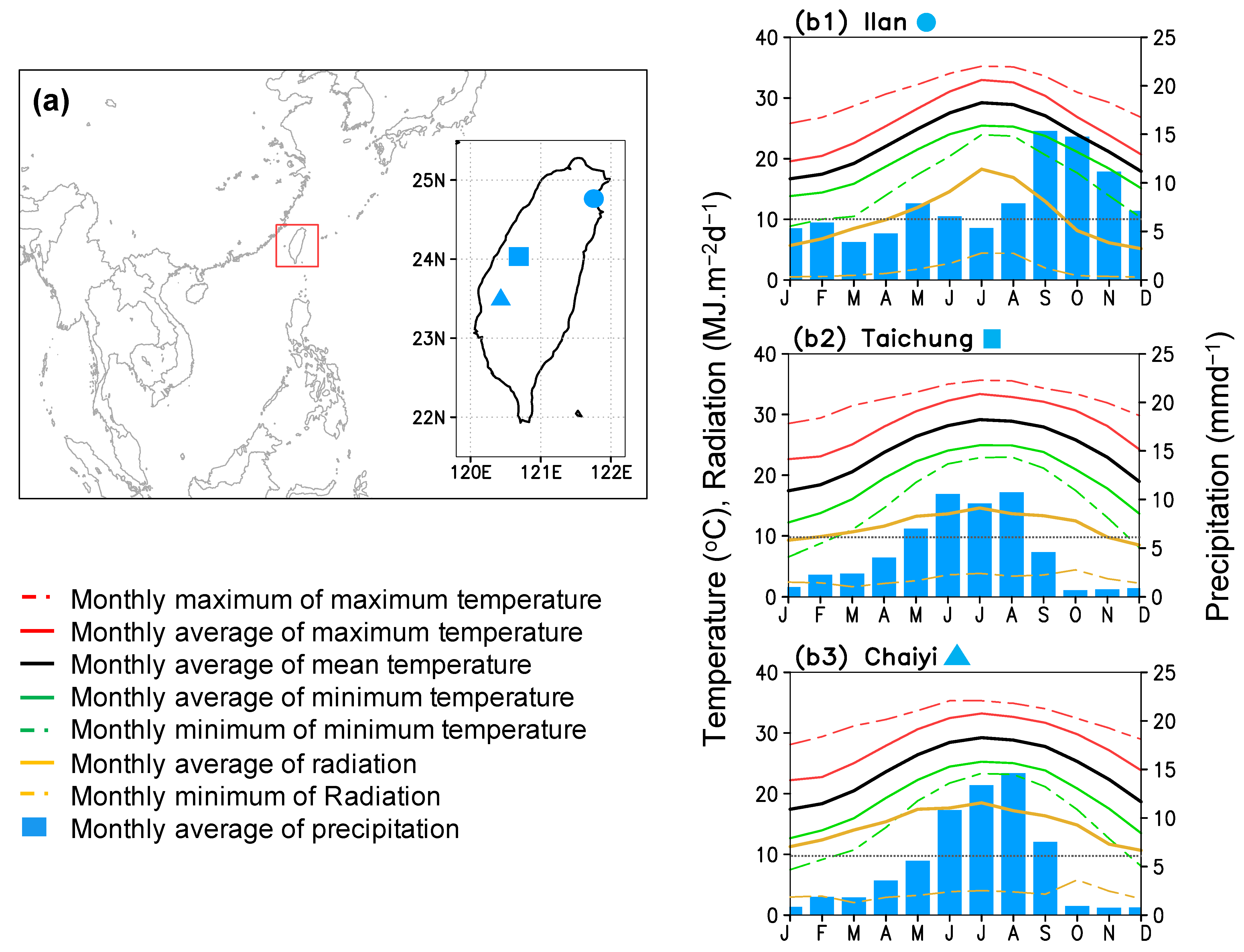

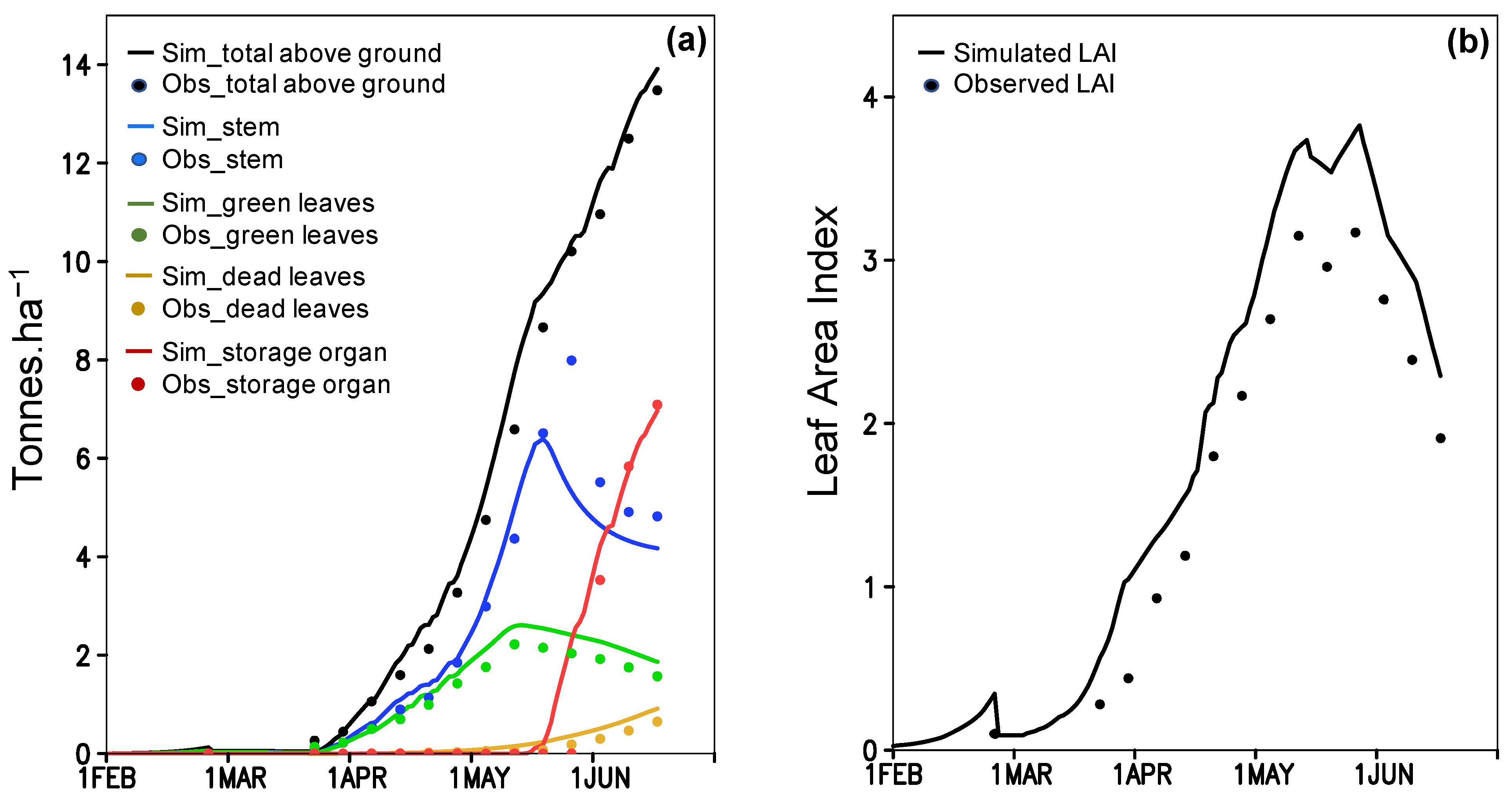

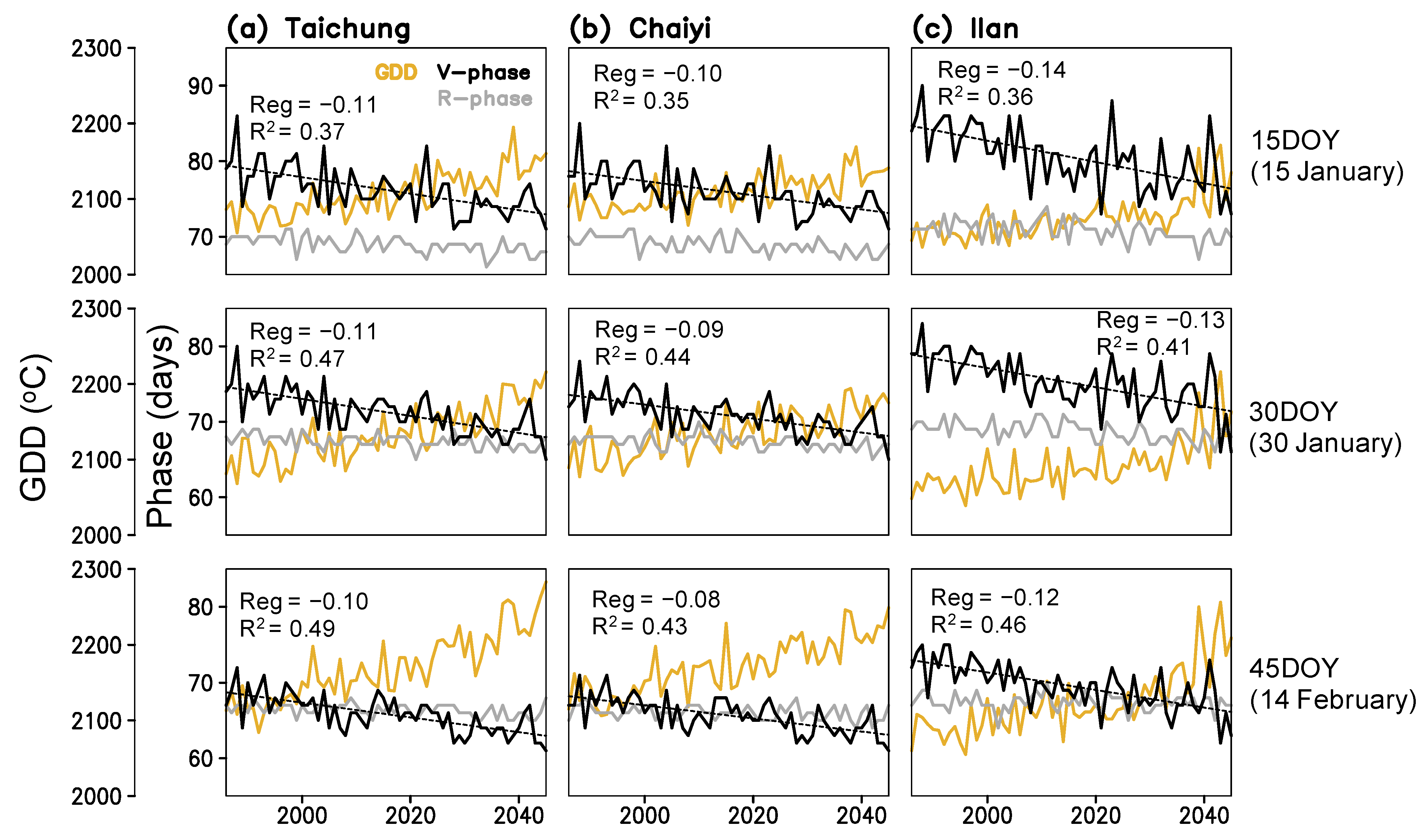
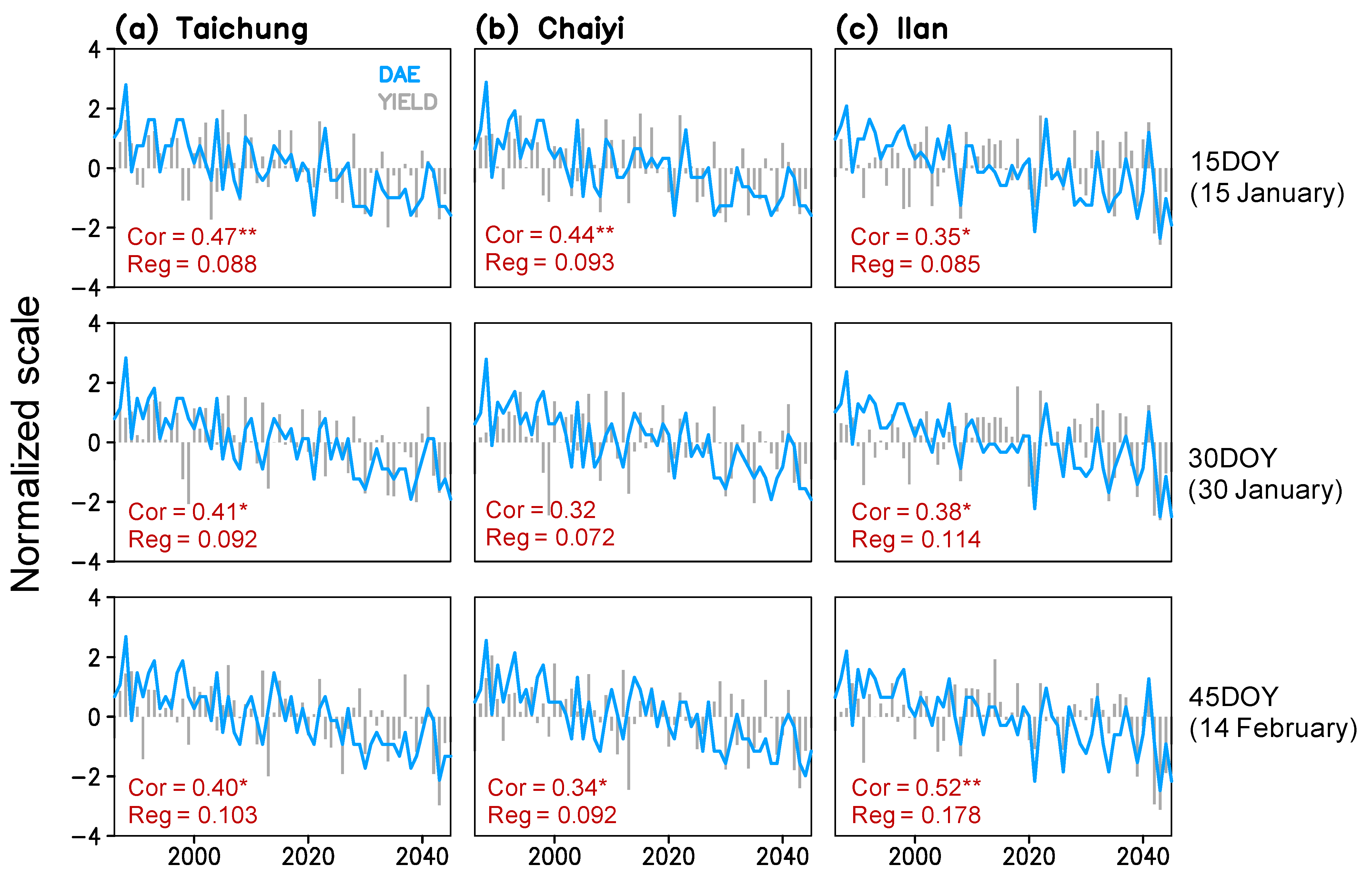


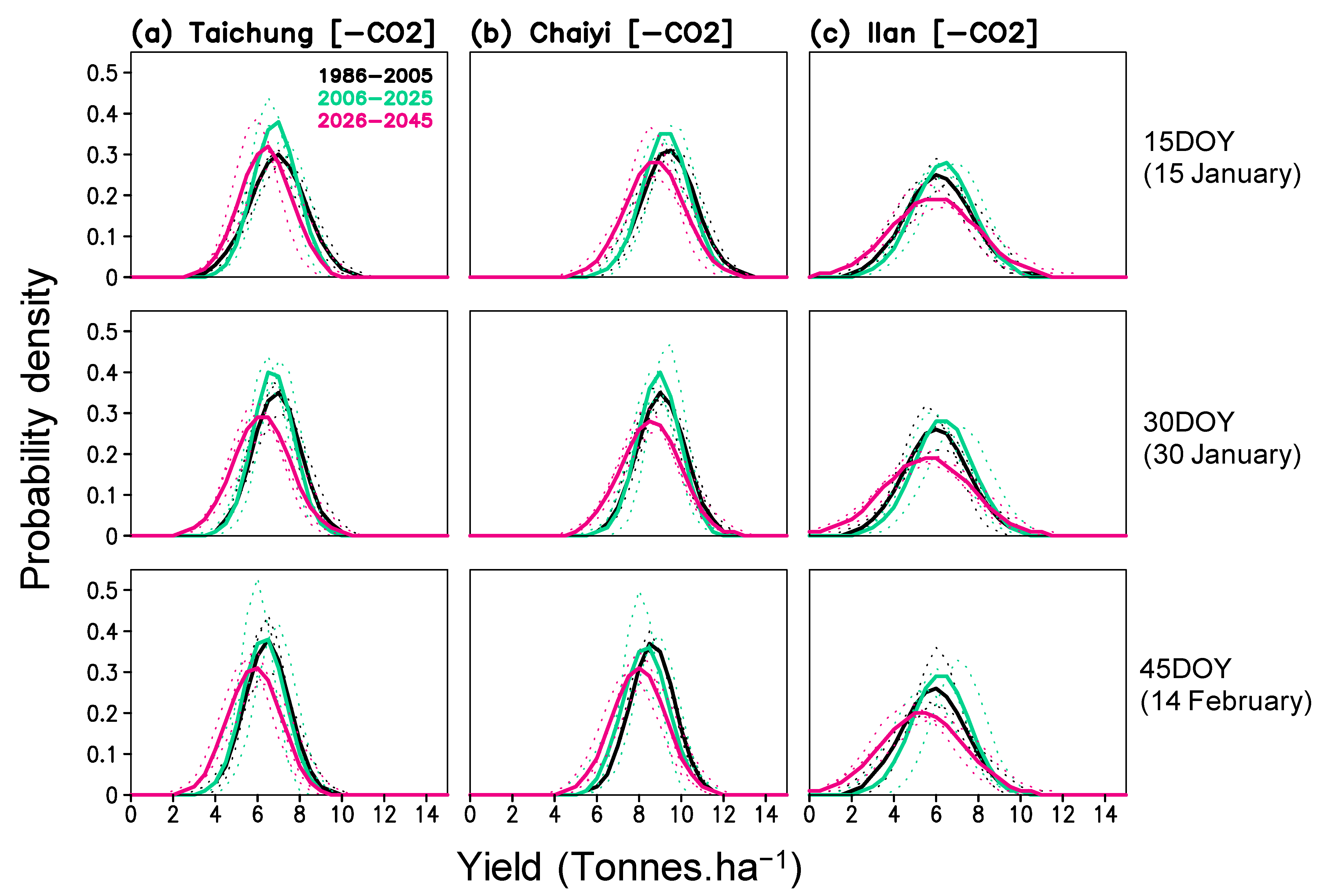
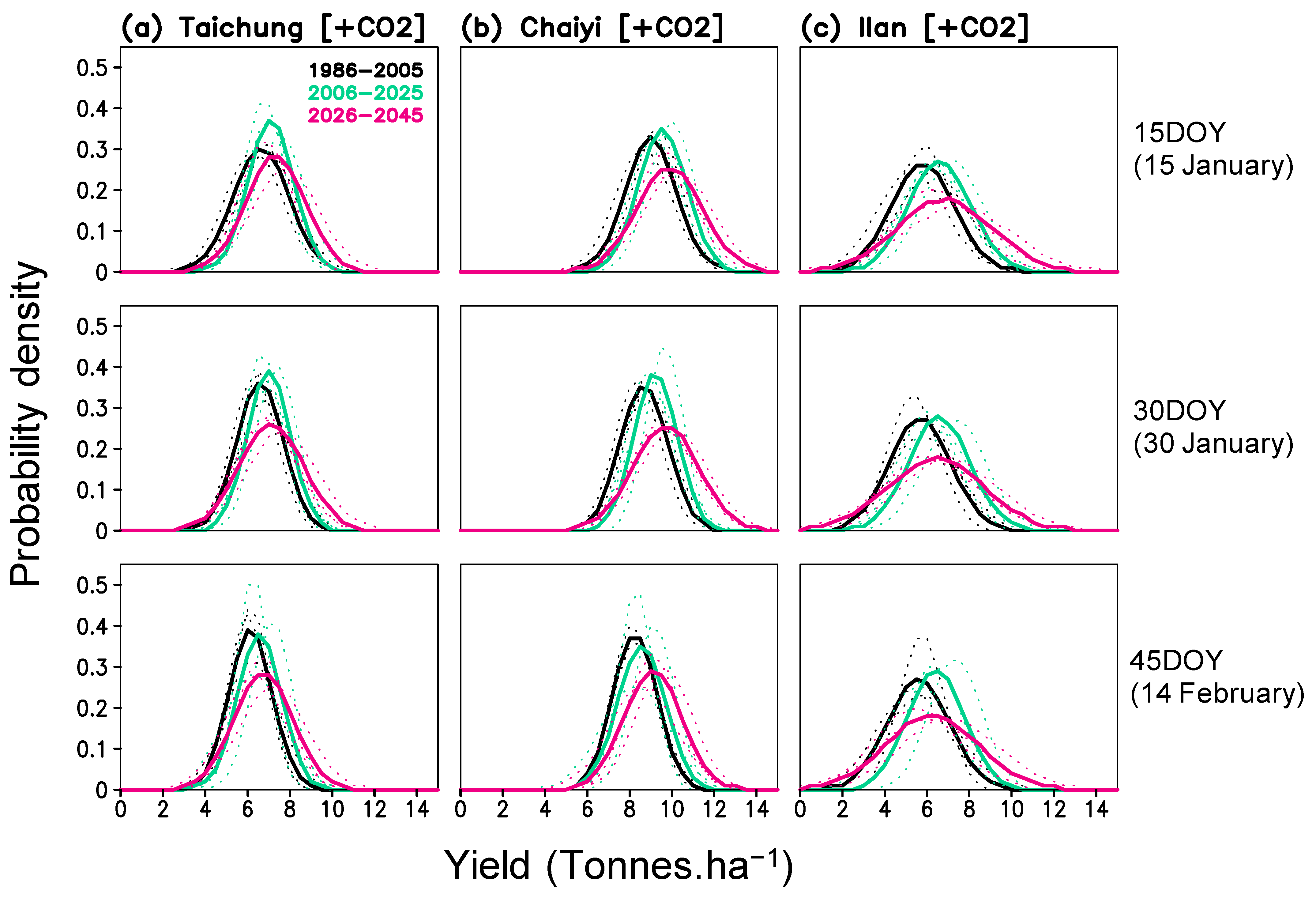
Publisher’s Note: MDPI stays neutral with regard to jurisdictional claims in published maps and institutional affiliations. |
© 2022 by the authors. Licensee MDPI, Basel, Switzerland. This article is an open access article distributed under the terms and conditions of the Creative Commons Attribution (CC BY) license (https://creativecommons.org/licenses/by/4.0/).
Share and Cite
Promchote, P.; Wang, S.-Y.S.; Yoon, J.-H.; Johnson, P.G.; Creech, E.; Shen, Y.; Yao, M.-H. On the Changing Cool Season Affecting Rice Growth and Yield in Taiwan. Agronomy 2022, 12, 2625. https://doi.org/10.3390/agronomy12112625
Promchote P, Wang S-YS, Yoon J-H, Johnson PG, Creech E, Shen Y, Yao M-H. On the Changing Cool Season Affecting Rice Growth and Yield in Taiwan. Agronomy. 2022; 12(11):2625. https://doi.org/10.3390/agronomy12112625
Chicago/Turabian StylePromchote, Parichart, Shih-Yu Simon Wang, Jin-Ho Yoon, Paul G. Johnson, Earl Creech, Yuan Shen, and Ming-Hwi Yao. 2022. "On the Changing Cool Season Affecting Rice Growth and Yield in Taiwan" Agronomy 12, no. 11: 2625. https://doi.org/10.3390/agronomy12112625
APA StylePromchote, P., Wang, S.-Y. S., Yoon, J.-H., Johnson, P. G., Creech, E., Shen, Y., & Yao, M.-H. (2022). On the Changing Cool Season Affecting Rice Growth and Yield in Taiwan. Agronomy, 12(11), 2625. https://doi.org/10.3390/agronomy12112625





